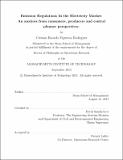Emission regulations in the electricity market : an analysis from consumers, producers and central planner perspectives
Author(s)
Figueroa Rodriguez, Cristian Ricardo
DownloadFull printable version (751.8Kb)
Other Contributors
Massachusetts Institute of Technology. Operations Research Center.
Advisor
David Simchi-Levi.
Terms of use
Metadata
Show full item recordAbstract
In the first part of this thesis, the objective is to identify optimal bidding strategies in the wholesale electricity market. We consider asymmetric producers submitting bids to a system operator. The system operator allocates demand via a single clearing price auction. The highest accepted bid sets the per unit market price payed by consumers. We find a pure Nash equilibrium to the bidding strategies of asymmetric producers unattainable in a symmetric model. Our results show that producers with relatively large capacities are able to exercise market power. However, the market may seem competitive due to the large number of producers serving demand. The objective of the second part of the thesis, is to compare two regulation policies: a fixed transfer price, such as tax regulation, and a permit system, such as cap-and-trade. For this purpose, we analyze an economy where risk neutral manufacturers satisfy price sensitive demand. The objective of the regulation established by the central planner is to achieve an external objective, e.g. reduce pollution or limit consumption of scarce resource. When demand is uncertain, designing these regulations to achieve the same expected level of the external objective results in the same expected consumer price but very different manufacturers' expected profit and central planner revenue. For instance, our results show that when the firms are price takers, the manufacturers with the worst technology always prefer a tax policy. Interestingly, we identify conditions under which the manufacturers with the cleanest technology benefit from higher expected profit as tax rate increases. In the third part of the thesis, we investigate the impact labeling decisions have on the supply chain. We consider a two stage supply chain consisting of a supplier and a retailer. Demand is considered stochastic, decreasing in price and increasing in a quality parameter, e.g. carbon emissions. The unit production cost for the supplier is increasing in the quality level chosen. We identify two different contracts that maximize the efficiency of the supply chain while allowing the different parties to achieve their objectives individually.
Description
Thesis (Ph. D.)--Massachusetts Institute of Technology, Sloan School of Management, Operations Research Center, 2013. This electronic version was submitted by the student author. The certified thesis is available in the Institute Archives and Special Collections. Cataloged from student-submitted PDF version of thesis. Includes bibliographical references (pages 119-122).
Date issued
2013Department
Massachusetts Institute of Technology. Operations Research Center; Sloan School of ManagementPublisher
Massachusetts Institute of Technology
Keywords
Operations Research Center.